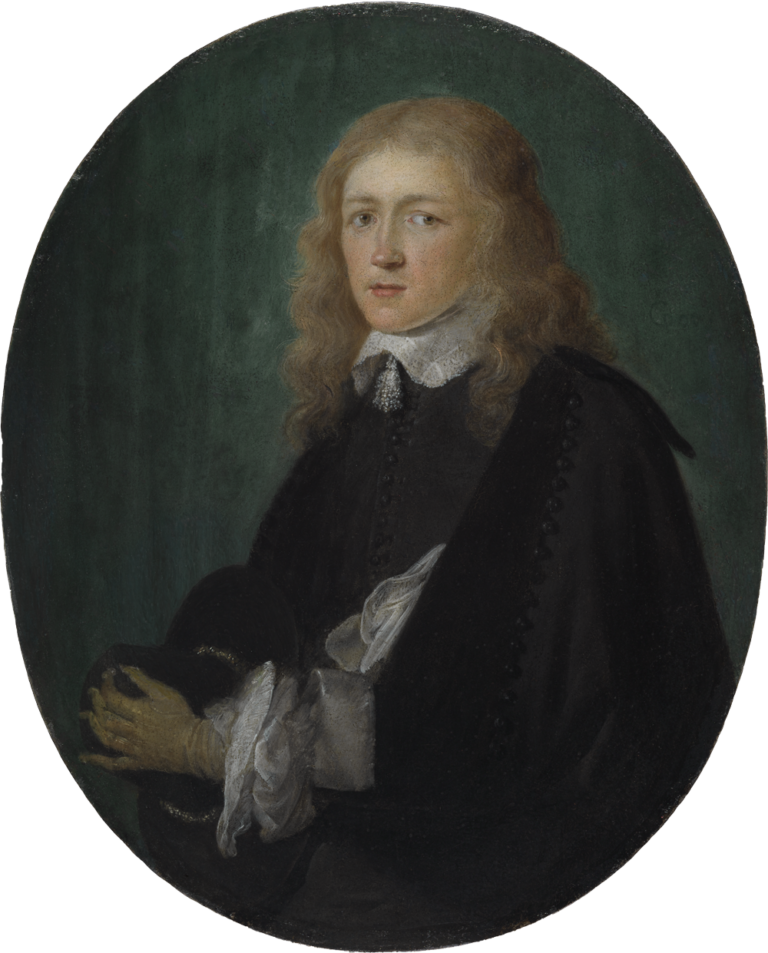This small, enamel-like portrait, which portrays Dirck van Beresteyn (1627–53) shortly before his untimely death at the age of twenty-six, is one of the few instances in which the identity of one of Gerrit Dou’s sitters is known.1 His name and life dates are inscribed on the reverse of the painting (fig 1).2 Dirck was the fourth of five children from a well-to-do family in Delft, whose father and grandfather had both held prominent civic positions as burgomasters of Delft.3 In the fall of 1647, at the age of twenty, Dirck moved to Leiden to study law at Leiden University. After the completion of his studies, he was appointed to the prestigious position of Counsel to the Hof van Holland. In November 1652 Dirck married his young cousin, Magdalena van Adrichem (1639–84) and settled in Delft on the west side of the Oude Delft.4 In 1653 Dirck made a series of visits to the notary to establish and revise his will, which suggests that he had fallen ill or was otherwise concerned about his mortality.5 He made his last notarial visit in September 1653 to ensure that his unborn child would be placed in the custody of his wife, mother and brother Zacharias.6 A week later he died, leaving behind his young bride Magdalena, who would give birth to a boy some six months later. Sadly, the child would only live for a matter of hours.7
Dou has depicted Dirck as a composed yet dashing young man dressed in the latest fashion. He wears a small ornamental band around his neck, edged with fine lace and closed with tasseled band-strings. His black doublet, faced with buttons down its front, allows his billowing shirt to show through at the cuffs and along the slits of his sleeves.8 A velvet-lined black cloak with additional buttons along its arms is slung around his shoulders. With beaming eyes, Dirck’s bright countenance is accentuated by his long, wavy hair cascading over his shoulders. His golden hair and black-and-white attire are set off by a vibrant blue-green backdrop that appears to be a curtain.9
Dou must have executed this portrait sometime between 1647, when Dirck first moved to Leiden, and 1653, the year of his death. Ronni Baer suggests a date close to 1647 and relates the painting stylistically to Dou’s 1646 signed and dated Portrait of a Man in the Rijksmuseum (fig 2).10 However, Dirck’s fashionable attire would seem to indicate a slightly later date for this portrait. In particular, the style of the sleeves of his doublet, which allow for much of his blousy shirt to show through, is consistent with men’s fashion of the early 1650s.11
Portrait of Dirck van Beresteyn is the smallest known work by Dou. The miniature scale implies a sentimental connection between the subject and the viewer, a scale the viewer experiences in the intimacy of one’s hands. Baer suggests that the portrait might have been commissioned on the occasion of Dirck’s extended absence from the family home in Delft upon his matriculation at Leiden University in 1647.12 The possibility of a slightly later dating, based on his dress, leads to another, perhaps more compelling, possibility. Because of its unusually small format, it is conceivable that the portrait was commissioned by Dirck as a gift for his wife, either for their betrothal or as a token of his love around the time of their marriage in 1652. Such small portrait gifts presented at a marriage proposal were not uncommon. This tradition is recorded in a painting by Caspar Netscher (ca. 1639–84), Presentation of a Medallion Portrait (fig 3), ca. 1658–60, in the Szépmüveszéti Muzeum, Budapest, which portrays a young suitor offering a small portrait medallion to his beloved.13
In addition to its diminutive size, the present portrait is also the only known work by the artist painted on a metal support, which laboratory testing has indicated to be an unusual alloy of silver and copper.14 Its uncommon metallurgical content has raised the possibility that the plate was adopted from a prior use and reappointed here as the smooth, stable support of a painting. One compelling proposition, which accounts for both the size and oval shape of the plate yet warrants further consideration and study, is that it was originally fashioned as a hand-mirror or component of a locket.15 Aside from its distinctive historical and technical qualities, this diminutive painting is of great significance to the present collector, as it was the first Dutch painting he acquired, and served as the springboard for assembling this remarkable collection of paintings by Gerrit Dou and his contemporaries.


